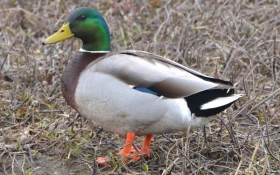
Mallard Duck
Anas platyrhynchos
Animal Behavior: After the breeding season, mallards form flocks and migrate from northern latitudes to warmer southern areas. There they wait and feed until the breeding season starts again. Some mallards, however, may choose to stay through the winter in areas where food and shelter are abundant these mallards make up a resident populations.
Native Habitat: North America
Eating Habits: Mallards consume a wide variety of foods, including vegetation, insects, worms, gastropods and arthropods, although they are not restricted to these. They also take advantage of human food sources, such as gleaning grain from crops.
Range: Mallards can be found almost anywhere in the world. They dominate the Northern Hemisphere, and can be found easily in Oceana, Asia, Africa, South America and many islands
Conservation Efforts: Mallards are the most abundant and widespread of all waterfowl every year millions are harvested by hunters with little effect on their numbers. The greatest threat to mallards is loss of habitat, but they readily adapt to human disturbances.
Animal Facts: Most often, they prefer wetlands, where highly productive waters produce large amounts of floating, emergent and submerged vegetation Wetlands also produce a great deal of aquatic invertebrates on which mallards feed. Mallard males leave the hen soon after mating occurs. The hen usually lays 9 -13 eggs in a nest on the ground near a body of water. Average life span in the wild is 26 years.
